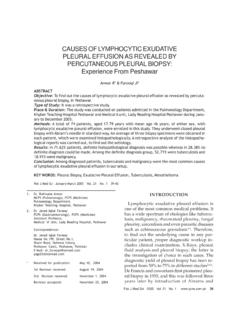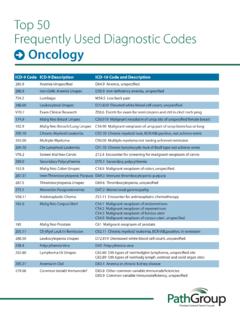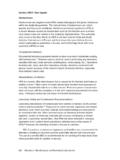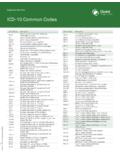Transcription of Leukemia: AML, CML, ALL and CLL - - RN.org®
1 leukemia : AML, CML, all and CLL Reviewed September 2017, Expires September 2019 Provider Information and Specifics available on our Website Unauthorized Distribution Prohibited 2017 , , , LLC By Wanda Lockwood, RN, BA, MA Purpose The purpose of this course is to define leukemia , describe current treatment, and describe the characteristics, symptoms, diagnosis, and treatment for the 4 primary types of leukemia : AML, CML, ALL, and CLL. Goals Upon completion of this course, the healthcare provider should be able to: Define leukemia . Discuss hematopoiesis of leukemia . Differentiate between acute and chronic forms. Describe at least 8 common symptoms of leukemia . Discuss normal and abnormal laboratory tests. Explain how to calculate the absolute neutrophil count. Discuss the implications of neutropenia. Discuss the normal platelet count and the implications of thrombocytopenia.
2 Discuss the 3 common stages of chemotherapy. Explain the cell cycle and the difference between cell cycle-specific agents and cell cycle-non-specific agents. Discuss 10 different types of chemotherapeutic agents. Explain 3 types of radiation commonly used for leukemia . Discuss hematopoietic stem cell transplantation. Discuss acute myelogenous leukemia (AML), including characteristics, symptoms, diagnostic findings, and treatment considerations. Discuss subtypes of AML. Discuss chronic myelogenous leukemia (CML), including characteristics, symptoms, diagnostic findings, and treatment considerations. Discuss the 3 different phases of CML. Discuss acute lymphocytic leukemia (ALL), including characteristics, symptoms, diagnostic findings, and treatment considerations. Discuss subtypes of ALL. Discuss chronic lymphocytic leukemia (CLL), including characteristics, symptoms, diagnostic findings, and treatment considerations.
3 Discuss two classification systems for CLL. Introduction leukemia is a group of malignant disorders affecting the blood and blood-forming tissues in the bone marrow, lymphatic system, and spleen. The word leukemia literally means white blood because it is a neoplastic proliferation of one type of blood cell, typically a leukocyte or white blood cell. Leukocytosis, an increased white blood cell count, is a normal response to infection, but when leukocytosis becomes chronic or progressively elevates without obvious cause, then it may indicate malignancy. In 2010, approximately 43,050 men and women (24,690 men and 21,840 women) in the United States were diagnosed with leukemia , and 21,840 died of the disease. leukemia accounts for 33% of cancers in children and 1340 deaths yearly, so it is often thought of as a disease of childhood. In children, the highest incidence is between 1 to 4 and the highest death rate between 10 and 19.
4 However, incidence is 10 times higher in adults. The median age for diagnosis is 66, and median age of death from leukemia is 74. Despite much research into leukemia , the cause is often elusive. leukemia appears to result from a combination of factors, which can include genetic predisposition, chromosomal changes, chemical agents (benzene), chemotherapeutic agents, radiation, immunocompromise, and viruses. Although viruses have been tied to leukemias in animals, only adult T cell leukemia is known to result from a virus, human T cell leukemia virus type 1 (HTLV-1). Regardless of the type of leukemia , the abnormal cells in the bone marrow depress production of other cells, resulting in a number of adverse effects: Anemia occurs as erythrocyte (red blood cell) production falls. Risk of infection occurs if neutrophil count decreases. Clotting factors decrease, increasing risk of bleeding as thrombocytopenia (reduced platelet count) occurs.
5 Risk of physiological fracture increases as periosteum weakens because of proliferation of cells in the bone marrow. Hypertrophy and fibrosis may occur in other organs, such as the liver, spleen, and lymph glands because of infiltration of malignant cells. Increased intracranial pressure, ventricular dilation, and irritation of the meniges with resultant headache, vomiting, papilledema, nuchal rigidity, coma, and death can occur from infiltration of malignant cells into the central nervous system. Hypermetabolic state deprives cells of nutrients and causes loss of appetite, weight loss, general fatigue, and muscle atrophy. Classification Hematopoiesis, the process by which blood cells are formed, involves production of specific cells from stem cell precursors according to body needs. In leukemia , a defect occurs in the myeloid or the lymphoid stem cell.
6 The most common feature of all types of leukemia is unregulated proliferation of leukocytes in the bone marrow. Leukemias are classified as lymphoid or myeloid, depending on the affected stem cell type. Usually leukemias classified as blast cell or stem cell refer to lymphoid defects. Additionally, leukemias are classified as acute or chronic. The 4 primary types of leukemia are acute lymphocytic /lymphoblastic leukemia (ALL), acute myelogenous leukemia (AML) or acute nonlymphoblastic leukemia (ANLL), chronic myelogenous leukemia (CML), and chronic lymphocytic leukemia (CLL) with a number of subtypes. Leukemias are often referred to by a number of different names, depending on the involved cell, and this can be confusing at times. acute and chronic forms differ in cell maturity and onset: acute forms: Onset is often abrupt, within weeks, and death may occur within weeks to months without treatment.
7 Proliferation of abnormal cells leaves little room for normal cell production. Cells may proliferate in the liver and spleen as well, and they may infiltrate other organs, such as the meninges, gums, lymph nodes, and skin. Typically, leukocyte development halts at the blast phase, so most affected leukocytes are undifferentiated or blasts. With acute leukemia , the white blood count may remain low because the cells are halted at the blast stage. acute forms may occur in both adults and children. Chronic forms: Onset is much slower, often over months or years. Normal cell production may occur as well for a long period of time, but in late stages of chronic disease, the abnormal cells interfere with normal cell production. The majority of leukocytes are mature. Chronic forms are rare in children. Laboratory tests Leukocytes are white blood cells (WBCs).
8 Normal total values vary according to age. The white count usually increases with infection and returns to normal when infection subsides. Leukocyte count Total 1-3 years: 6000 to 17,500 8-13 years: 4500 to 13,500 Adult: 4500 to 11,000 The differential is the percentage of each type of leukocyte out of the total. An increase in the white blood cell count is usually related to an increase in one type and often an increase in immature neutrophils, known as bands, referred to as a shift to the left, generally an indication of an infectious process. Normal WBC for adults: 4,500-11,000. acute infection: 11,000+, 30,000 indicates a severe infection. Viral infection: 4,000 and below. Because the proportion of most leukocytes is small, only an increase in neutrophils or lymphocytes is usually significant enough to result in increased total white count with leukemia .
9 Differential Cell type 1 yr 10 yrs Adult Neutrophils (Total) 31% 54% 59% Neutrophils (bands) 3% 3% Neutrophils (segments) 28% 51% 58% Absolute neutrophil count (ANC) 1500 to 8500 1800 to 8000 1800 to 7700 Lymphocytes 61% 38% 34% Monocytes 4% Eosinophils Basophils Absolute neutrophil count (ANC) is an important measure used to determine the degree of neuotropenia. The total ANC should be about 1800 to 2000 mmm3 or higher. Risk of infection is significant if the level falls to 1000 and severe at 500. ANC is not calculated directly but is determined from the total white count and the percentages of neutrophils and bands: ANC = Total WBC X (% neutrophils + % bands/100 Using this formula, if the white blood count is 3200 with 70% neutrophils and 3% bands, the calculation would indicate that despite the low WBC count, the patient does not have neutropenia: ANC = 3000 X 73/100 = 2190 If the white count is 5300 with 10% neutrophils and 1% bands, neutropenia is evident despite the normal WBC: ANC = 5300 X 11/100 = 583 Why is neutropenia important?)
10 The ANC falls with increased destruction of neutrophils or decreased production. With leukemia , neutropenia is a direct result of both the leukemic disease process and chemotherapy used to treat it, so it is a primary concern during therapy. Neutropenia increases the risk of both exogenous (environmental) and endogenous (GI tract, skin) infection, depending on the severity and duration. A short-lasting severe neutropenia may pose less actual risk than a longer mild neutropenia. There are no specific symptoms related to neutropenia, so without regular blood testing, it may go undiagnosed until infection occurs. In some cases, chemotherapy is withheld or reduced until the ANC rises, but this puts the patient at increased risk from the malignancy, especially if the treatment has a potential for cure. In that case, growth factors (G-CSF or CM-CSF) may be administered to stimulate production.















